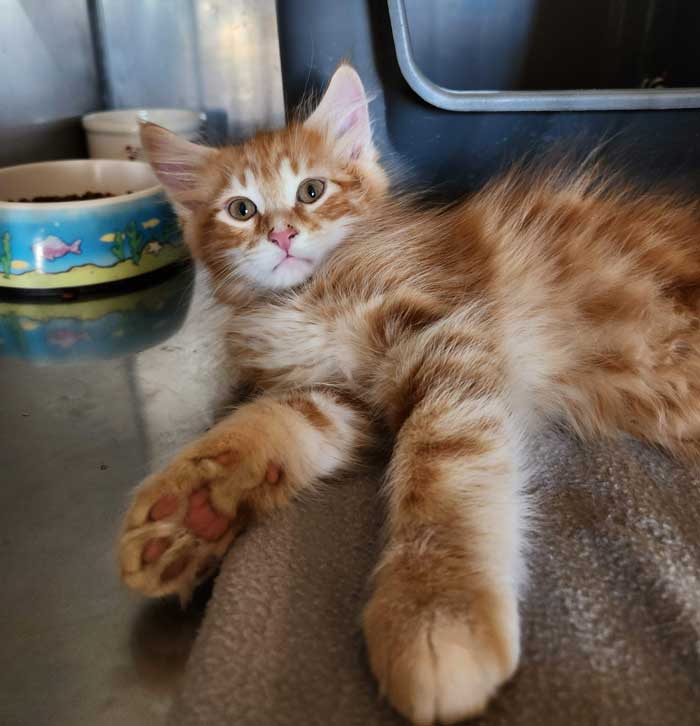Community (Feral) Cat Program
United Animal Friends® works with homeowners to manage the local feral cat population by providing free spay/neuter surgeries. Research has shown that Trap/Neuter/Return (TNR) is the most humane and effective way to care for feral cat colonies. UAF does not remove cats from colonies. Feral cats are altered, vaccinated against rabies, tattooed and ear-tipped (ear-tipping is the universal symbol that a feral cat has been altered). The homeowner returns the cat to their home and continues to monitor the colony for any new cats that need to be altered.
Donations are appreciated. We are able to provide this service through local contributions and the efforts of our volunteers. We rely on the public to keep this program going. The Community (Feral) Cat Program is partially funded through donations from the N.O.A.H. Foundation and the Arizona Companion Animals Spay and Neuter Committee.
Program Guidelines:
- A feral cat is wild, born and living outdoors, and will bite if you try to handle it. This program is not for house pets or one you are converting to a house pet.
- UAF provides free spay/neuter certificates for feral cats through our Spay/Neuter Certificate Program. Obtaining a certificate from UAF is required prior to proceeding. Click here to apply for a certificate.
- Once you have a certificate, click here to make your appointment.
- When making the appointment, name the cat “Feral” and guess the sex (we will check before we do the surgery). On the day of the appointment, you may bring any unaltered cat you trap – even if it’s not the one you expected to trap.
Preparing to Trap:
- UAF has live (humane) traps to loan for those who have an appointment. To borrow, call 928-350-5430 or email [email protected] to schedule a trap pickup. Plan to pick up 5-7 days BEFORE your appointment.
- Place the trap(s) 5-7 days before your appointment so the cats get used to seeing it and eating INSIDE the trap. Prop the door open with a bungee cord, string, etc.
- Place trap in one area, don’t keep moving it. Anytime you change ANYTHING, they become frightened and will stay away as they sense something is up. Be consistent.
- Keep the trap covered partway with a dark towel/blanket. Don’t let it move with the wind – it frightens them and they will not go into the trap.
- Pick a consistent time for feeding so cats know when to show up. Remove the food after 30 minutes. You are now training them in advance to show up at a specific time.
- Feed them in the trap for 5-7 days before your appointment. Use a paper plate torn in half.
- Do not put towels, plates, bowls, newspapers etc. inside the trap. It will interfere with the closing of the trap door and cats can get tangled up in the items.
- Don’t feed at night—you’re inviting wildlife (skunks) and EVERY cat in the area. This creates a breeding ground, and you become part of the problem. For every one cat you see, there are many more coming in at night to feed.
Actual Trapping:
- Withhold food for 24hrs prior to actual trapping so they are hungry. (Water is OK.)
- The night before your appointment, set the trap:
- It should still be in the same spot, still partially covered.
- Use “smelly” foods, such as tuna or sardines.
- Plan to watch the trap – don’t leave unattended.
- Once the cat is trapped, immediately cover the trap so the cat doesn’t injure itself.
- IF YOU CAN’T CATCH THE CAT, let us know. We will keep moving the appointment until you catch it.
Click here for a video on how to trap a cat
Transport:
- Put trapped cat in vehicle on a tarp or cardboard.
- Cover the trap to keep them calm.
- If you borrowed a trap, you may wish to bring an empty cat carrier to drop off with the cat. After surgery, we can place the cat in the carrier for return transport and you can leave the borrowed trap with us.
- Cover the trap or carrier during return transport.
Recovery:
- Keep trap or carrier covered and leave the cat in it for 24hrs so the surgery drugs have a chance to leave their system, and they are fully awake and safe to be released.
- Release next morning back to where you trapped it. They will resume their normal habits.
We are able to provide this service through donations and the efforts of our volunteers. Your donation can help. This program is partially funded by the N.O.A.H. Foundation and the Arizona Companion Animals Spay and Neuter Committee.
- Funding for the N.O.A.H. Foundation is raised through sales at the N.O.A.H. Thrift Store, located at 603 S. Granite Street in Prescott.
- Funding for the Arizona Companion Animals Spay and Neuter Committee is raised through the sale of Pet-Friendly License Plates and donations through Arizona Resident Personal Income Tax Return Form 140. For information on how you can obtain a Pet-Friendly License Plate or donate through your tax return, visit their website at www.azpetplates.org.

